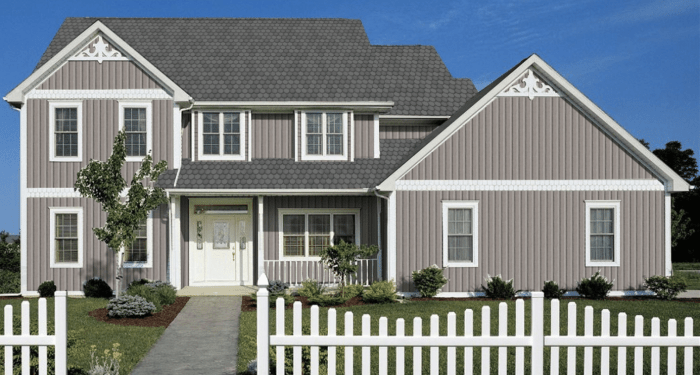Delve into the world of home exteriors roofing with this in-depth guide that covers everything from materials to design trends and maintenance tips. Get ready to discover the secrets behind creating a stunning and sustainable roof for your home.
Learn about the different roofing materials, design trends, maintenance practices, and eco-friendly options that can transform your home's exterior.
Types of Roofing Materials for Home Exteriors
When it comes to choosing the right roofing material for your home exterior, there are several options to consider. Each type of roofing material has its own unique characteristics in terms of durability and aesthetic appeal. Let's explore some of the most popular choices such as asphalt shingles, metal roofing, and clay tiles.Asphalt Shingles
Asphalt shingles are one of the most common roofing materials used in residential properties. They are cost-effective, easy to install, and come in a variety of colors and styles. While asphalt shingles may not be as durable as other materials, they provide a good balance between affordability and performance. Homes with asphalt shingle roofs typically have a traditional and classic look.Metal Roofing
Metal roofing is known for its longevity and durability. It can last for 50 years or more, making it a popular choice for homeowners looking for a long-term roofing solution. Metal roofs are also energy-efficient and environmentally friendly. Homes with metal roofing often have a modern and sleek appearance, adding a contemporary touch to the overall aesthetic.Clay Tiles
Clay tiles are a timeless roofing material that offers both durability and elegance. They are known for their ability to withstand harsh weather conditions and resist fading over time. Clay tiles come in various shapes and colors, allowing homeowners to achieve a unique and sophisticated look for their home exterior. Homes with clay tile roofs often exude a Mediterranean or Spanish-style charm.Roofing Design Trends for Modern Homes
In today's modern home exteriors, roofing design trends play a crucial role in enhancing the overall aesthetic appeal of a house. From the style of the roof to the color choices, every aspect contributes to the visual impact of a home.Different roof styles such as gable, hip, and flat roofs have become popular choices for modern homes. A gable roof, with its triangular shape, adds a traditional and classic look to a house. On the other hand, hip roofs, with their slopes on all four sides, offer a more modern and sleek appearance. Flat roofs, although not as common, provide a minimalist and contemporary vibe to the overall design.When it comes to color choices for roofing, homeowners are leaning towards more neutral tones such as shades of grey, brown, and black. These colors blend seamlessly with various exterior architectural styles and materials, creating a cohesive and sophisticated look. Additionally, some homeowners are opting for bold choices like dark blues or greens to make a statement and add a touch of uniqueness to their homes.Innovative Roofing Materials
- One of the emerging trends in modern roofing design is the use of innovative materials such as solar tiles or green roofs. Solar tiles not only provide energy efficiency but also enhance the eco-friendliness of a home.
- Metal roofs are gaining popularity for their durability and versatility in design. They can mimic the look of other materials like wood or tile while offering superior protection against the elements.
- Living roofs, covered with vegetation, are becoming a sustainable choice for modern homes. They provide insulation, reduce stormwater runoff, and create a unique and eco-friendly aesthetic.
Maintenance Tips for Home Exteriors Roofing
Regular maintenance is crucial for ensuring the longevity and performance of your home's roofing. By following some best practices and implementing a seasonal schedule, you can keep your roof in top condition and prevent costly damage in the long run.Types of Roofing Materials and Maintenance
- Asphalt Shingles: Regularly inspect for cracks, missing shingles, and signs of wear. Replace damaged shingles promptly to prevent leaks.
- Metal Roofing: Check for rust, loose screws, and damaged panels. Clean debris and ensure proper drainage to prevent corrosion.
- Tile Roofing: Inspect for cracked or broken tiles and replace them as needed. Clean moss or algae buildup to prevent water damage.
- Wood Shingles: Look for signs of rot, mold, or insect infestations. Treat with preservatives and sealants to protect against moisture.
Seasonal Maintenance Schedule
Spring: Inspect for winter damage, clean gutters, and remove debris from the roof surface. Check for leaks and make necessary repairs. Summer: Trim overhanging branches, check for algae growth, and ensure proper ventilation in the attic. Repair any loose or damaged roofing materials. Fall: Clear gutters of leaves and debris, check flashing and seals for wear, and prepare for winter weather conditions. Inspect the roof for any signs of damage. Winter: Remove snow and ice buildup to prevent structural damage. Check for leaks and ice dams, and address any issues promptly.Importance of Regular Inspections and Repairs
- Early detection of problems can prevent major damage and costly repairs.
- Regular maintenance extends the lifespan of your roof and protects your home's structural integrity.
- Professional inspections can identify hidden issues and ensure your roof is in optimal condition.















